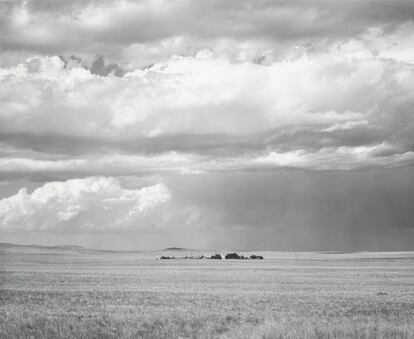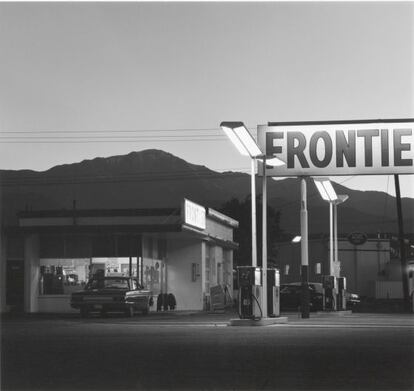The art of the Western world
The Reina Sofía reveals the work of US landscape photographer Robert Adams


The rivers, the poplar trees, the paths and highways, the electricity lines, the felled forests, the cemetery, the abandoned school... perhaps the Great American Novel is not in the hands of a writer but in the terse, concise and austere vision of one solitary photographer.
Born in New Jersey in 1937, Robert Adams has spent the last four decades scrutinizing the landscape of the prairies. The first retrospective of his work to be held in Europe is now running at Madrid's Reina Sofía Museum and contains all the pain, knowledge and epic poetry demanded of one of the most unfathomable mysteries of modern culture: the American West. "Mystery in this landscape is a certainty, an eloquent one," Adams has written.
Robert Adams: el lugar donde vivimos (Robert Adams: The Place We Live) features over 300 small-format photographs and more than 40 books, available in an exhibition space that, like one of the photographer's landscapes, is as bright as it is discreet. On arrival the only thing that strikes you is its huge size, but once you start looking at the series of photographs close up, the images gradually stop being miniscule points on the exhibition plan guiding you from room to room, town to town, and story to story.
The exhibition is an epic novel of the history of the US"
"Adams' photographs are read," says exhibition curator Joshua Chang, who is also responsible for the catalogue of the artist's work at the Yale University Art Gallery. "This is the most beautifully mounted Robert Adams exhibition I've ever seen. It is an epic novel of the history of the US. Each section is a chapter in that great story. An intimate journey, with no information beyond a few texts by the artist that encourage us to ask ourselves questions about the places in which we live." Adams was a sickly 15-year-old when his family moved to Colorado, where he discovered the great prairies. After studying literature in California, he returned to Colorado in the 1960s to teach.

"In common with many photographers, I began making pictures because I wanted to record what supports hope: the untranslatable mystery and beauty of the world," he writes. "Along the way, however, the camera also caught evidence against hope, and I eventually concluded that this too belonged in pictures if they were to be truthful and thus useful."
"In 1975, the New Topographics: Photographs of a Man-Altered Landscape exhibition changed the perception of the landscape that photography had offered to that point," notes Reina Sofía director Manuel Borja-Villel. "It included Nicholas Nixon, Lewis Baltz, Bernd and Hilla Becher... but above everyone else was Robert Adams, a photographer who remains unknown in our country. There are no romantic or idealistic concessions in his work. His reality is like that of a mapmaker. He works like an anthropologist or ethnologist, in the way Claude Lévi-Strauss expressed."
At the end of the exhibition there is a text that, for the museum's new deputy director João Fernandez, sums up "the ethic" of Adams's work. In the preface to his book The Place We Live , Adams quotes a verse by German poet Friedrich Hölderlin ("to live is to defend a form") that could serve as an "epigraph." "Throughout history, art has been an element of that defense, a testimony of our efforts to find harmony in the apparent contradictions."
And in this way he returns to the same problems: "For what did the author risk everything? Were there intolerable events? Was there promise? Was there some person, season, or book? Some tree or road?" On one of his trips to Keota, Colorado, Adams came across the grave of a man he had known in the prairies. The headstone read: "Clyde L. Stanley. Keota, my home for 63 years." The terseness of the statement fascinated him. "He must have thought about the words for a long time to conclude so unequivocally what mattered most, remembering I suppose the blizzards he'd watched through the front windows, the smell of sage after summer rains, the conversations he'd had with generations of neighbors... The place - that was who he was, by his love for it." After everything, perhaps a few short words might suffice for the Great American Novel.
Robert Adams: el lugar donde vivimos . Until May 20 at Museo Nacional Centro de Arte Reina Sofía, C/ Santa Isabel 52, Madrid. www.museoreinasofia.es
Tu suscripción se está usando en otro dispositivo
¿Quieres añadir otro usuario a tu suscripción?
Si continúas leyendo en este dispositivo, no se podrá leer en el otro.
FlechaTu suscripción se está usando en otro dispositivo y solo puedes acceder a EL PAÍS desde un dispositivo a la vez.
Si quieres compartir tu cuenta, cambia tu suscripción a la modalidad Premium, así podrás añadir otro usuario. Cada uno accederá con su propia cuenta de email, lo que os permitirá personalizar vuestra experiencia en EL PAÍS.
¿Tienes una suscripción de empresa? Accede aquí para contratar más cuentas.
En el caso de no saber quién está usando tu cuenta, te recomendamos cambiar tu contraseña aquí.
Si decides continuar compartiendo tu cuenta, este mensaje se mostrará en tu dispositivo y en el de la otra persona que está usando tu cuenta de forma indefinida, afectando a tu experiencia de lectura. Puedes consultar aquí los términos y condiciones de la suscripción digital.
Últimas noticias
Maduro pleads not guilty before the federal court in New York: ‘I am still the president of Venezuela’
A new test can detect Alzheimer’s from a finger prick
UN team enters Sudanese city of El Fasher after paramilitary massacre: ‘It’s like a ghost town’
A recipe for resistance: Indigenous peoples politicize their struggles from the kitchen
Most viewed
- Gilles Lipovetsky: ‘If you want to live better and fall in love, take Prozac, don’t look to philosophy’
- Alain Aspect, Nobel laureate in physics: ‘Einstein was so smart that he would have had to recognize quantum entanglement’
- Maduro’s downfall puts China’s relationship with Venezuela to the test
- Why oil has been at the center of Venezuela-US conflicts for decades
- Alvin Hellerstein, a 92-year-old judge appointed by Bill Clinton, to preside over Maduro’s trial in New York








































